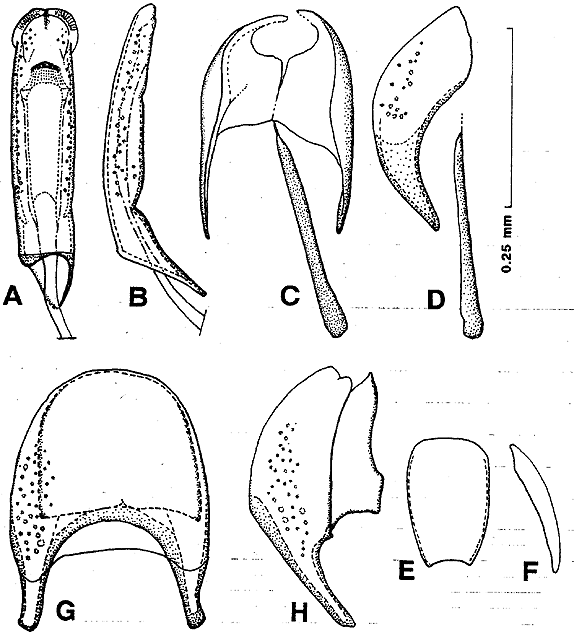

Head (Fig. 4B) densely and finely punctate, the punctures separated by 12 times their diameter.
Pronotal sides strongly convergent apically. Disk of pronotum sparsely and irregularly covered with coarse punctures that are separated by 112 times their diameter (Fig. 3D); fine punctures intermingled among the coarse punctures, separated by 25 times their diameter. Marginal stria completely impressed.
Epipleural marginal stria complete and crenate. Elytral marginal stria complete, sinuate and carinate. Another stria completely impressed between epipleural and elytral marginal striae. Subhumeral stria lightly and completely impressed. First to fifth dorsal striae absent. Sutural stria present on apical two-thirds and sparsely crenate. Punctation of elytra similar to that of pronotum, the coarse punctures absent medio-basally.
Propygidium (Fig. 4C) sparsely and coarsely punctate, the punctures uneven and separated by 0.57 times their diameter, and intermingled with fine punctures that are separated by about their own diameter. Punctation of pygidium similar to that of propygidium, the coarse punctures become sparser on apical half.
Anterior margin of prosternal lobe (Fig. 4D) broadly truncate, the median portion straight; marginal stria of lobe complete and broadly distant from margin on anterior portion; narrow band between margin and marginal stria transversely excavate and impunctate; disk of lobe densely covered with fine punctures that are separated by about twice their diameter. Prosternal keel longitudinal rectangular; the disk finely and sparsely punctate, the punctures a little coarser than those of lobe and separated by 13 times their diameter; interspace among the punctures covered with coriaceous ground microsculpture; carinal and prosternal lateral striae complete.
Anterior margin of mesosternum (Fig. 4E) nearly straight. Mesosternum short (width : length = 4 : 1), with punctaion similar to that of the prosternal keel; marginal stria broadly interrupted on median portion and crenate coarsely and carinate laterally. Meso-metasternal suture strongly and coarsely crenate. Intercoxal disk of metasternum even, sparsely and coarsely punctate, the punctures become finer medio-anteriorly and coarser latero-posteriorly and separated by 110 times their diameter; interspaces among the coarse punctures intermingled with fine punctures that are separated by 24 times their diameter; lateral disk sparsely and coarsely punctate, the punctures separated by 26 times their diameter and become finer and denser antero-laterally; lateral metasternal stria extending obliquely and laterally, reaching near apical one-third of length of lateral disk; mesocoxal stria obliquely and shortly impressed, reaching basal one-third.
Intercoxal disk of 1st abdominal sternum sparsely and coarsely punctate, the punctures separated by 14 times their diameter and become finer posteriorly; interspace among the coarse punctures intermingled with fine punctures; lateral stria impressed on basal two-thirds, curved outwardly, the posterior portion nearly straight; lateral disk sparsely and coarsely punctate.
Protibia with 16 small denticles on outer margin, the apical margin truncate.
Male genitalia as shown in Fig. 5; aedeagus slender; ratio in length of paramera to basal piece 4.68; parameres divided widely on apical half.
Distribution. Japan (Honshu).
Etymology. This species is named in honor of Mr. Satoshi Yamauchi of APM, who made a great contribution to this work by making material available for my study and arranging my visit to APM.
Remarks. In shape and size of the body, T. yamauchii
resembles some members of Anapleus of the subfamily Dendrophilinae,
which are, however, much different from yamauchii in having antennal
furrows along the prosternal keel.


